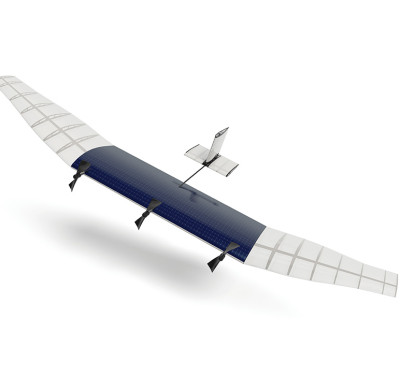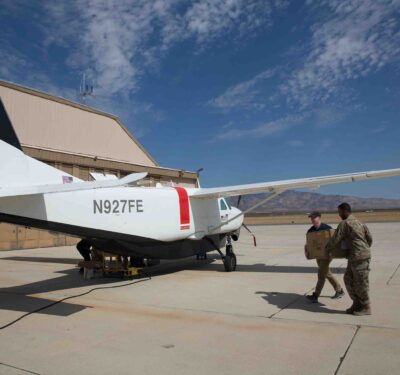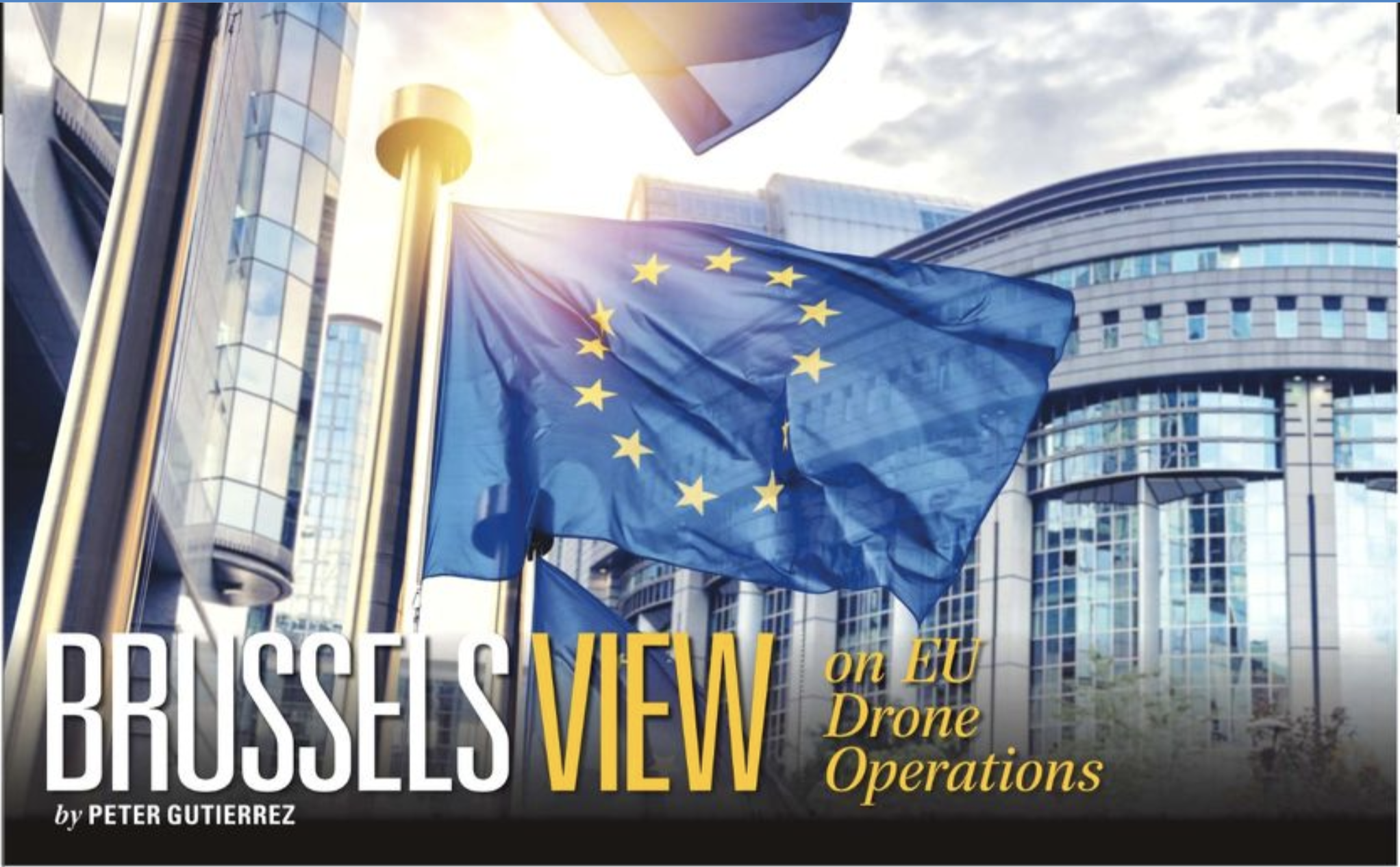
The new EU basic aviation regulation, as it pertains to drones, sets down in stone the key principles of ensuring safety, security, privacy, data protection and environmental protection. By itself, the basic regulation establishes such things as the registration threshold for drone operators; operators must be registered if the drones they operate can transmit more than 80 Joules of kinetic energy upon impact with a person.
The basic regulation also requires that drones be designed in such a way that they cannot put people at risk. For example, depending on its weight or area of operation, a drone may need to be equipped with automated landing features or collision avoidance systems.
Drone operators are also required to be aware of all the rules that apply to them, and many operators will have to join national registers, with their drones marked for identification.
Very importantly, the new basic regulation gives the European Aviation Safety Agency (EASA), which works closely with the  European Commission, the authority to formally guide future developments in the field of unmanned aircraft systems (UAS), i.e. without the necessity for further high-level EU legislative approval.
European Commission, the authority to formally guide future developments in the field of unmanned aircraft systems (UAS), i.e. without the necessity for further high-level EU legislative approval.
BASIC REGULATION ADOPTED, UAS PART STILL TO COME
With the key principles outlined in the basic aviation regulation as a rough guide, EASA and the European Commission are now proceeding with the delineation of specific and comprehensive EU-wide rules for civil drones. These rules, heretofore referred to as the EU UAS regulation, will address matters such as maximum altitude and distance limits for drone flight, and how and by whom operations will need to be authorized. The rules will specify which operators need to be registered, who needs more training and which drones need to have additional safety features.
The aim will be to deliver a UAS regulation that can be put into force by national authorities across the continent, enabling the harmonization and standardization of the whole European commercial drone operations market.
Speaking at the EASA Workshop on ‘UAS Standard Scenarios’ in Cologne in July, European Commission Administrator Koen de Vos said, “We want to open up the drone services market, and we want to see this translated into what matters for European citizens—economic growth and jobs. We believe EASA’s strong and robust global approach is the correct one, in keeping with the JARUS process.”
JARUS is the Joint Authorities for Rulemaking on Unmanned Systems, a group of experts from national aviation authorities and regional aviation safety organizations around the world. Together, they are working toward a single set of technical, safety and operational requirements for the certification and safe deployment of drones.
“By following a global process, we facilitate the work for our operators and our businesses,” de Vos said. “This is, after all, a global technology, and we want to open up not only the European market but also look to opportunities in the global market.”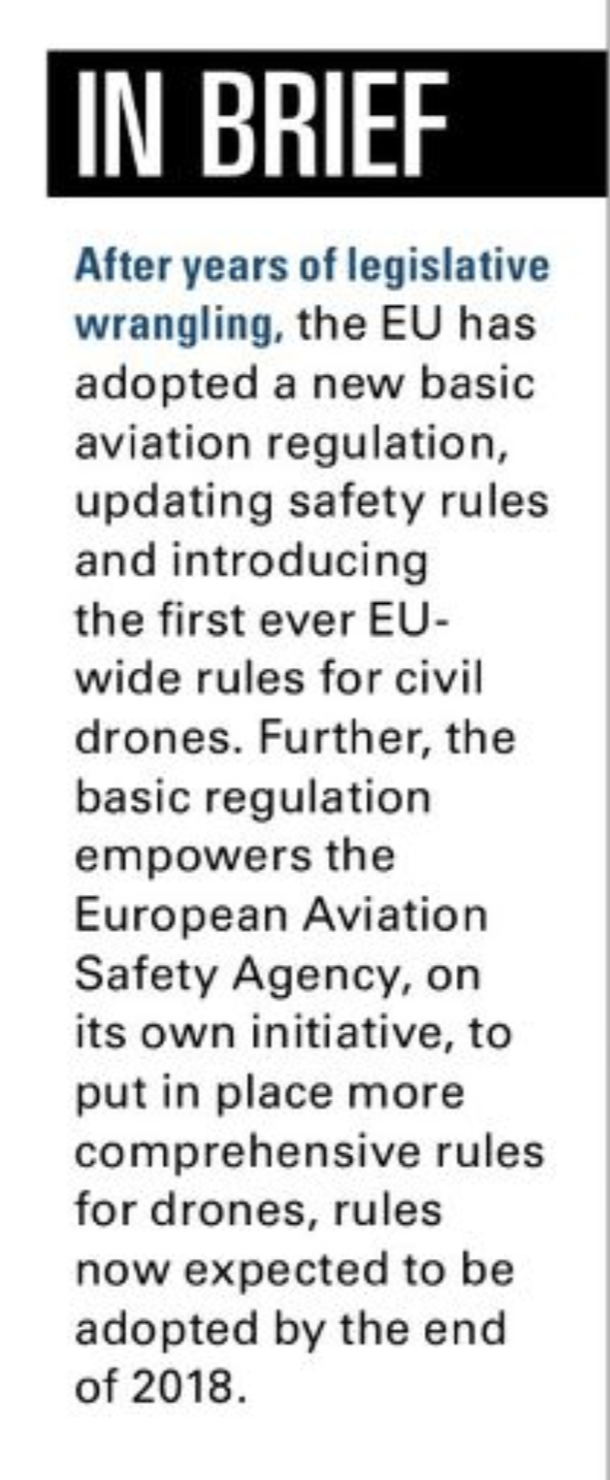
Safety, security, and privacy are all of utmost importance to maintaining societal acceptance of drones, he said. “Without the trust of citizens, the drone services market could easily backfire.
“The new basic rule is an enormous piece of regulatory instrument in place,” he said, “allowing us to start further elaborating our drone regulatory framework. This then provides us with a legal basis to adopt, by the end of the year, the UAS regulation.”
Just to be clear, if and when the UAS regulation is ‘adopted’ by the EU, that won’t exactly be the end of the process. Readers will remember the remarks made earlier this year in Munich by Dominic Hayes, European Commission manager of spectrum and policy for Galileo and EGNOS. He told us, speaking about the UAS regulation, “The draft I’ve seen seems quite advanced, and I expect it to be in place this year. That means that it’s then up to the [EU] member states to implement it. But I do think this is one that they would want to implement.”
Also earlier this year, in Nuremberg, we spoke to Julia Gonschorek, who is a project manager and research fellow at Germany’s influential European Aviation Security Center (EASC). She said, “As far as I know the [EU UAS] regulation will come. But we are not so sure about when exactly it would start in Germany. Not before 2025-2030, in any case, because even if the Union accepts it, passes it, then Germany still has to decide for itself.”
OPENING THE FLOODGATES
The detailed rules for drones are already largely mapped out. During the long months when the EU Parliament and Council were negotiating adoption of the basic aviation regulation, EASA and the European Commission, in consultation with member states and other stakeholders, continued to refine and clarify their ideas in relation to the eventual detailed UAS regulation.
As many readers will be aware, EASA ‘Opinions’ on the subject have already been released, laying out, for example, the ‘concept of operations’, wherein drone rules are to be ‘operations-centric’, focusing on how a drone is to be used rather than on its physical configuration.
The current EASA/EC proposal establishes three categories of operation: ‘open’ (low risk), ‘specific’ (medium risk) and ‘certified’ (higher risk), with different safety parameters for each. These include such things as how high a drone is allowed to fly, over what kind of terrain or populations, the distance between drone and pilot and how near to restricted zones an unmanned aircraft may fly.
Briefly, the ‘open’ category includes operations where safety is ensured through compliance with operational limitations, mass and energy limitations, product safety requirements and a minimum set of operational rules. Aircraft should be equipped with a system limiting performance to acceptable values. Examples include toys or ‘hobbyist’ operations.
In the ‘specific’ category, authorization by a national aviation authority (NAA) will be required, possibly assisted by a qualified entity, following a risk assessment performed by the operator. Examples of such operations could include broadcast media flying a drone in an urban environment. Finally, in the ‘certified’ category, requirements will be comparable to those for manned aviation, including oversight by NAAs.
For the Commission one of the immediate concerns is to avoid seeing national authorities overwhelmed by authorization applications when the UAS regulation comes into force.
According to long-established practice in aviation, authorization to fly is based on aircraft type and characteristics, and a given aircraft remains certified whenever and for whatever purpose it is used. Under the newly proposed operations-based system, what matters will be how and where said aircraft is to be used. Thus, every unique operation will have to be authorized, regardless of whether the operator is using the same aircraft. And this could lead to a big problem.
“The national certification authorities (NCAs) will be confronted with a huge number of requests to fly, to operate, and they are mostly still working in a ‘paper mode’,” de Vos said. “We do not believe it will be possible for the NCAs to continue to check and approve each and every drone operation.”
With this looming challenge in mind, one of the central topics of the workshop in Cologne was the development of so-called ‘standard scenarios’ that will allow a level of automation in the authorization process.
RISK ASSESSMENT AND OPERATIONAL CATEGORIES
The key, it turns out, to understanding how standard scenarios will work is to first understand how risk assessment works.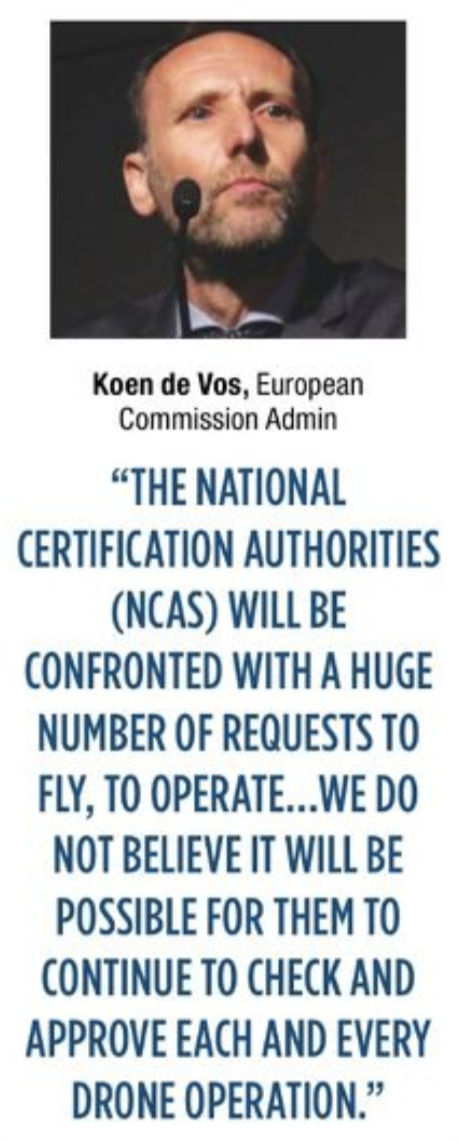
The starting point for all operators will be to apply for authorization to fly under one of the three operational categories—open, specific or certified. Which of the three categories they can fly under will depend on the level of risk entailed by their specific operation. Determining that level of risk will mean carrying out a risk assessment.
Lorenzo Murzilli is manager for innovation and advanced technologies, at Switzerland’s Federal Office of Civil Aviation. He leads the JARUS working group concerned with risk assessment. He started his presentation at the Cologne workshop by explaining a new methodology called ‘Specific Operations Risk Assessment’ (SORA), intended for use by UAS operators applying for authorization within the ‘specific’ category.
In fact, SORA is a rather complex and tedious process, involving the tabulation of operational perimeters and evaluating risk in terms safety, privacy and security. It’s so tedious, in fact, that Murzilli underscored the desirableness of not having to do a SORA at all. And that’s where the standard scenario comes in.
“The idea with standard scenarios is that we ‘pre-cook’, to already have an assessment ready to fit certain types of operations, so you don’t have to do the SORA,” Murzilli said.
“This is about automatic approvals. We are in the digital age, we rely and we want to rely heavily on digitization, we don’t want to see forms and papers. Are you kidding me? Can you really imagine doing this with a paper and a pencil? But that’s another question.
“As far as the standard scenarios, if standard kinds of operations are being done over and over, we can just do one SORA to cover that kind of operation, and then based on that we tell you how to comply in terms of your parameters.”
“We think that the standard scenarios should become very, very powerful tools to open up the drones services market,” de Vos said, “to release up operations that are in market demand, where we free the way for businesses. Starting by developing the right standard scenarios will help, of course. We need descriptions of scenarios that not only are sufficiently clear but also cover a sufficient number of operations that are in demand.”
De Vos said the Commission wants to see standard scenarios that are applicable and that will be mutually recognized and binding across European borders and even farther afield.
Carine Donzel-Defigier, deputy head, Aeronautic Industry Department and General Secretary of the Civil Drones Council at the French General Directorate for Civil Aviation, underlined the importance of striking the right balance between standard scenarios and mission-specific authorization.
“In France, we have about 5,000 operators and the number of jobs is estimated at about 10,000,” she said. “So that means about two people per operator. So every time one of these operators will want to operate in the ‘specific’ category—and that can come very quickly, they just need to fly above 120 meters or just need to fly BVLOS or something else—they will have to get either an authorization or be able to use a standard scenario.
“We need to get the number of standard scenarios right, because if you get too many you will have operators wondering whether their mission belongs to standard scenario number 13 or if it is not standard scenario number 49, and perhaps the national authority reviewing it will think that number 35 might be more appropriate.”
So the more standard scenarios there are, the more complicated it will be to define the right one for the mission. “But the fewer standard scenarios there are, the more complicated it will be for both operators and national authorities to fulfill the safety and risk assessment,” Donzel-Defigier said.
With that, we understand a first set of standard scenarios is to be published at the end of this year, as part of the detailed UAS regulation package.
Virtually all of the discussion at the workshop concerned authorization to work in the ‘specific’ category, assuming that this will probably represent the vast bulk of initial civil drone operations.
The European Commission says ‘certified’ category standards have not yet been developed, and are likely to emerge only in the medium term. The Commission is currently working on defining logical ‘descriminants’ that will make the differences between the specific and certified categories clear to operators.
OTHER ITEMS IMPACTING THE EU DRONE PICTURE
The European drone landscape is showing movement on a number of fronts beyond the regulatory. De Vos confirmed when asked that the U-space initiative, for example, remains high on the political agenda.
A concept developed by the Single European Sky ATM Research (SESAR) Joint Undertaking, the U-space has been described as a drone-oriented system similar to that of Air Traffic Management for manned aviation. The aim is to integrate into an ATM context complex drone operations in all types of environments, including urban zones, with a high degree of automation.
According to current SESAR information, the system should be up and running by 2019, delivering basic services such as registration, e-identification and geo-fencing. Further U-space services and corresponding standards are to be developed subsequently.
“The U-space is something that is mentioned consistently during our various consultation meetings,” de Vos said, “so people are aware that U-space could provide very useful tools and could facilitate the lives of drone operators and of authorities.
“The question is to which extent already do the Commission regulations on the table provide the basic stepping stones of registration, e-identification, geo-awareness, and to what extent can we, or do we, need to develop further steps. In order to answer these questions, we have established a reflection group with some member states and industry people, and we will in the coming days send out a final report with recommendations.
“To regulate on a full U-space, we will need to take another regulatory initiative,” de Vos suggested, or warned, “and then the question is how fast can we develop this new regulatory initiative. This is still under consideration within the Commission and with stakeholders. How fast can we go? Do we have to learn from expertise, from demonstrators, or is there already a sufficient evidence base to come up with a first draft of a U-space regulation?”
GOOD WORKING ORDER
Sitting in the audience at the Cologne workshop, Manfred Mohr of the International Air Transport Association (IATA) had been listening to the proceedings with interest. The theme of striking the right balance seemed to be a recurring one throughout the workshop. Too many standard scenarios or too few? Too many regulations to push through at once or not enough?”
“Too simple or too complex?” he interjected. “I say just do it right. We at IATA, from the ATM side, our members, we have our experience already with ADS-B, ADS-C, data link. This is chaos. Nobody knows when it will come into place. We are working heavily on the extension of all of these deadlines and multi-frequencies. So please, do it right, do it safe, do it secure, but do it fair.”
Essentially, Mohr seemed to be calling for order and good sense, and his voice seemed to resonate among the other participants, possibly an indication of some general feeling of frustration among the drone and drone-impacted communities.
“The controllers,” he said, “don’t want to see drones on their radar screens. The problem is we have no tracking system at the moment. Most of these drones are not seen, and if you see a drone it is not coordinated. This is our problem. The controllers—I just asked my colleague—of course they want to see it if it’s coordinated or if it’s really a safety issue, they are not against this, but we need a proper tracking system. We need this e-identification system, this is a fantastic idea of course.
“Think about when you go into place with a new aircraft,” he said. “This process is taking sometimes between five and six years. Please, don’t let it take that long for your new drone arrangements, because most of the companies mentioned by the lady from France, they will already be bankrupt.”
PRIVACY, PRIVACY
The recently unveiled EU General Data Protection Regulation (GDPR) has shaken up the way the continent does business, and many other things. It has real implications for drone operations, all of which drone operators are expected to understand, not the least of which concern the ‘privacy’ element within the infamous operational risk assessment.
On that front, Jean Pierre Lentz, European Commission policy officer, delivered some good news to drone operators. The EU-funded project ‘DRONERULES.eu’ is currently developing tools aimed at helping drone operators comply with new GDPR requirements.
“There are already some guidelines available to help you,” Lentz said, “but we wanted to provide you with more specific guidelines for drone operations and some other useful tools. So this project will feed its results into the DRONERULES.eu website that some of you already know.”
Topics already covered include safety, privacy and insurance, and the new tools will cover the privacy dimension, including, specifically, the GDPR.
“There will also be an e-learning course to help pilots and manufacturers to better understand what privacy and data protection issues may be covered by their operations, and also a privacy impact assessment template and app,” Lentz said.
“I think this is quite necessary, because most operators, when they are up in the air, are focusing on their business. They are not, except in some cases, interested in various odd people that might be standing around on the ground. But it’s not because you are looking at a power line that you may not take a picture of someone sitting in their back garden. Of course we don’t focus on these people, but in this case you have actually captured their personal data and some legal obligation falls upon you.
“This privacy issue should really be built into the drone business,” Lentz concluded, “because this would really support the acceptance by citizens. It’s not only about complying with the legal requirements, the GDPR. If you see a drone flying over your house, it might not even have a camera onboard, but people could feel attacked. So this kind of thing must be taken into account.”
FINAL SAY
The EU UAS scene has changed quite a bit since the European Commission first launched its ‘Roadmap for the integration of civil RPAS into the European Aviation System’ in 2013, a year now known in certain European circles as ‘the year of the ‘drone.’ Obviously, the industry has made great strides and is likely to continue to do so, with or without an European UAS regulation.
That said, by working in concert with the global JARUS process, EASA and the Commission are moving in the right direction. Whether it now takes until 2030 or whether member states find it in their interests to move more quickly, the new UAS regulation seems bound eventually to be implemented and to have a positive effect in terms of EU-wide, and perhaps even worldwide, cross-border drone business.


